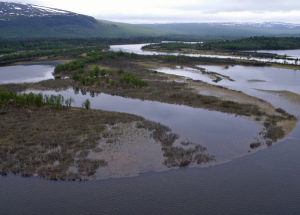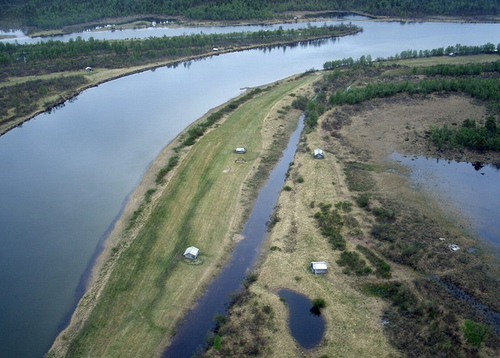 GEDSC DIGITAL CAMERA
GEDSC DIGITAL CAMERA Floods didn’t make floodplains fertile during the dawn of human agriculture in the Earth’s far north because the waters were virtually devoid of nitrogen, unlike other areas of the globe scientists have studied.
Instead, the hardy Norsemen and early inhabitants of Russia and Canada have microorganisms called cyanobacteria to mostly thank for abundant grasses that attracted game to hunt and then provided fodder once cattle were domesticated. The process is still underway in the region’s pristine floodplains.
The new findings are surprising because it’s long been assumed that nitrogen crucial to plant growth mainly arrived with floods of river water each spring, according to Thomas DeLuca, a University of Washington professor of environmental and forest sciences and lead author of a paper in the Nov. 6, 2013 issue of the journal PLOS ONE.
Discovering that cyanobacteria in the floodplains were responsible for nitrogen fixation – that is taking it from the atmosphere and “fixing” it into a form plants can use – partially resolves the scientific debate of how humans harvested grasses there for hundreds of years without fertilizing, DeLuca said. It raises the question of whether farmers today might reduce fertilizer use by taking advantage of cyanobacteria that occur, not just in the floodplains studied, but in soils around the world, he said.
It also might lead to more accurate models of nitrogen in river systems because none of the prominent models consider nitrogen being fixed in floodplains, DeLuca said. Scientists model nitrogen loading of rivers, especially where industrial fertilizers and effluent from wastewater-treatment plants cause dead zones and other problems in the lower reaches and mouths of rivers.
Ten rivers and 71 flood plains were studied in northern Fennoscandia, a region that includes parts of Scandinavia and Finland. The rivers were chosen because their upper reaches are pristine, haven’t been dammed and are not subject to sources of human-caused nitrogen enrichment – much like river systems humans encountered there hundreds of years ago, as agriculture emerged in such “boreal” habitats. Boreal habitat – found at 60 degrees latitude and north all the way into the Arctic Circle, where it meets tundra habitat – is the second largest biome or habitat type on Earth.
In the northern regions of the boreal, the surrounding hillsides have thin, infertile soils and lack shrubs or herbs that can fix nitrogen. In these uplands, feather mosses create a microhabitat for cyanobacteria, which fix a modest amount of nitrogen that mostly stays on site in soils, trees and shrubs. Little of it reaches waterways. On the floodplains, high rates of nitrogen fixation occur in thick slimy black mats of cyanobacteria growing in seasonably submerged sediments and coating the exposed roots and stems of willows and sedges.
“We joke and call the floodplains the ‘mangroves of the North’ because there are almost impenetrable tangles of willow tree roots in places, like a micro version of the tropical and subtropical mangroves that are known to harbor highly active colonies of cyanobacteria,” DeLuca said.
“It turns out there’s a lot of nitrogen fixation going on in both,” he said. For example, the scientists discovered that in spite of the dark, cold, snowy winters of Northern Sweden, the cyanobacteria there fix nitrogen at rates similar to those living the life in the toasty, sun-warmed Florida Everglades.
_______________________________________________________________________________________________________________________
Huts used for storing fodder dot the floodplains, where sedges have been harvested for hundreds of years without additional fertilization. Early settlers cleared willows to encourage and harvest sedges and grasses. Credit: T DeLuca/U of Washington
_______________________________________________________________________________________________________________________
The amount of nitrogen provided by the cyanobacteria to unharvested willows and sedges is perhaps a quarter of what U.S. farmers in the Midwest apply in industrial fertilizers to grain crops and as little as a sixth of what they apply to corn.
Human-made fertilizers can be fuel-intensive to produce and use, for example, it takes the energy of about a gallon of diesel to produce 4 pounds of nitrogen fertilizer. In developing countries in particular, nitrogen fertilization rates are spiraling upward, driving up fossil-fuel consumption, DeLuca said. Meanwhile, cyanobacteria naturally occurring in farm soils aren’t fixing nitrogen at all in the presence of all that fertilizer, they just don’t expend the energy when nitrogen is so readily available, he said.
“Although modest in comparison to modern fertilization, the observation that cyanobacteria could drive the productivity of these boreal floodplain systems so effectively for so long makes one question whether cyanobacteria could be used to maintain the productivity of agricultural systems, without large synthetic nitrogen fertilizer inputs,” he said.
______________________
Source Credit: Sandra Hines, University of Washington press release.
Co-authors of the paper are Olle Zackrisson and Ingela Bergman with the Institute for Subarctic Landscape Research, Sweden, Beatriz Díez
Cover Photo, Top Left: Sedges and willow trees get the nitrogen they need from cyanobacteria living in the sediments of pristine boreal floodplains found at 60 degrees latitude and north into the Arctic Circle. Credit: T DeLuca/U of Washington
_______________________________________________________________________________________________________________________________________________
Read about the most fascinating discoveries with a premium subscription to Popular Archaeology Magazine. Find out what Popular Archaeology Magazine is all about. AND MORE:
 Popular Archaeology’s annual Discovery edition is a selection of the best stories published in Popular Archaeology Magazine in past issues, with an emphasis on some of the most significant, groundbreaking, or fascinating discoveries in the fields of archaeology and paleoanthropology and related fields. At least some of the articles have been updated or revised specifically for the Discovery edition. We can confidently say that there is no other single issue of an archaeology-related magazine, paper print or online, that contains as much major feature article content as this one. The latest issue, volume 2, has just been released. Go to the Discovery edition page for more information.
Popular Archaeology’s annual Discovery edition is a selection of the best stories published in Popular Archaeology Magazine in past issues, with an emphasis on some of the most significant, groundbreaking, or fascinating discoveries in the fields of archaeology and paleoanthropology and related fields. At least some of the articles have been updated or revised specifically for the Discovery edition. We can confidently say that there is no other single issue of an archaeology-related magazine, paper print or online, that contains as much major feature article content as this one. The latest issue, volume 2, has just been released. Go to the Discovery edition page for more information.
Subscription Price: A very affordable $5.75 for those who are not already premium subscribers of Popular Archaeology Magazine (It is FREE for premium subscribers to Popular Archaeology). Premium subscribers should email [email protected] and request the special coupon code. Or, for the e-Book version, it can be purchased for only $3.99 at Amazon.com.






